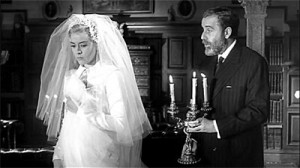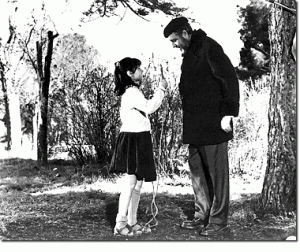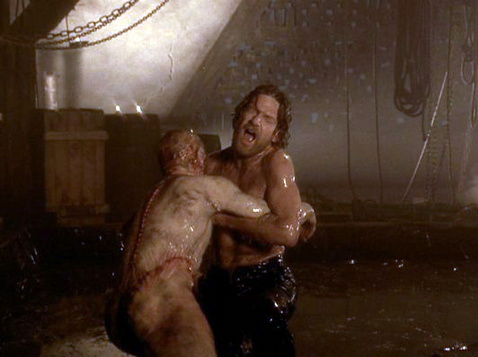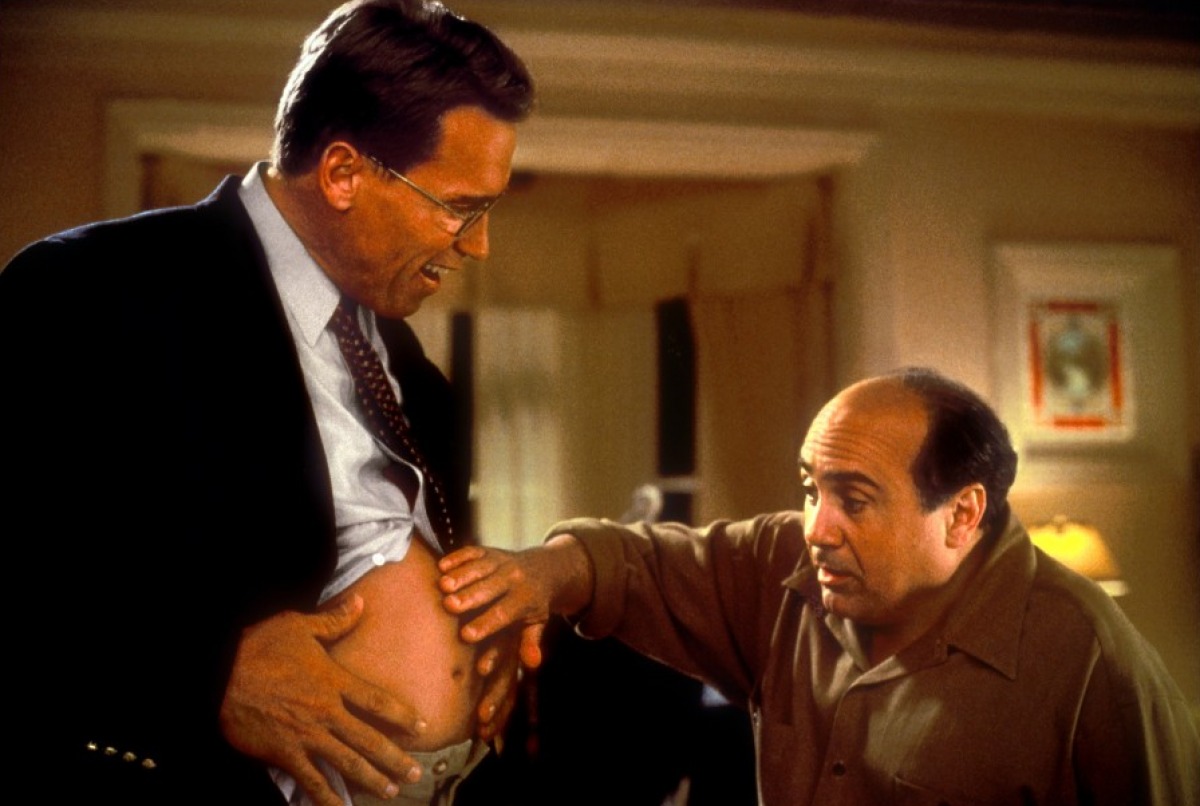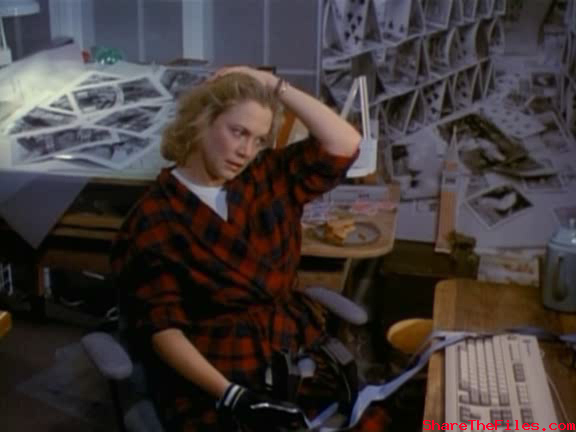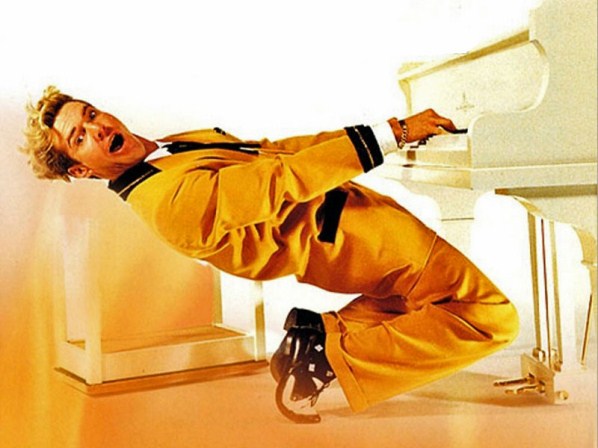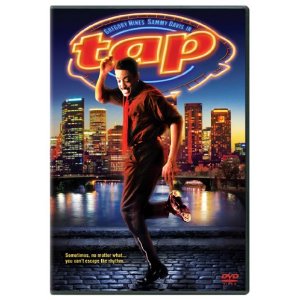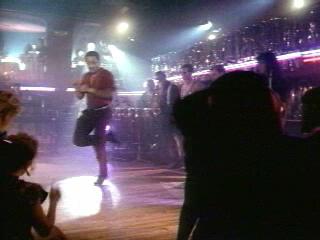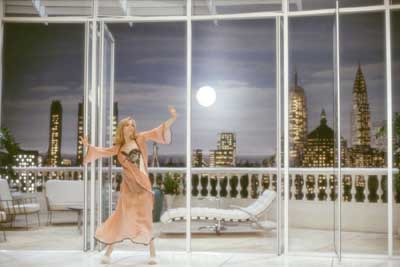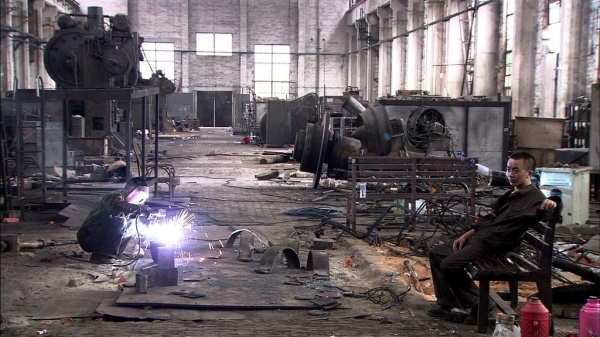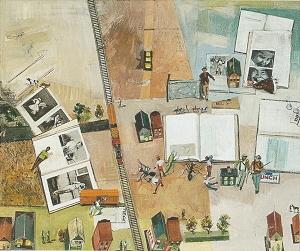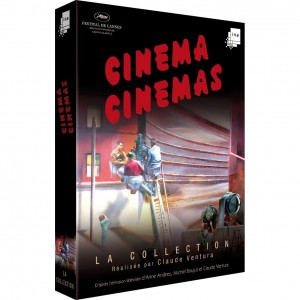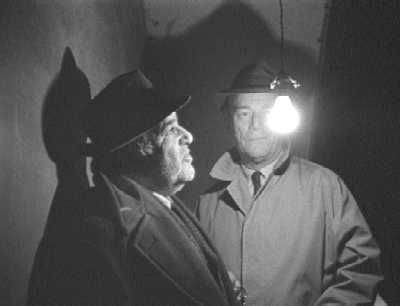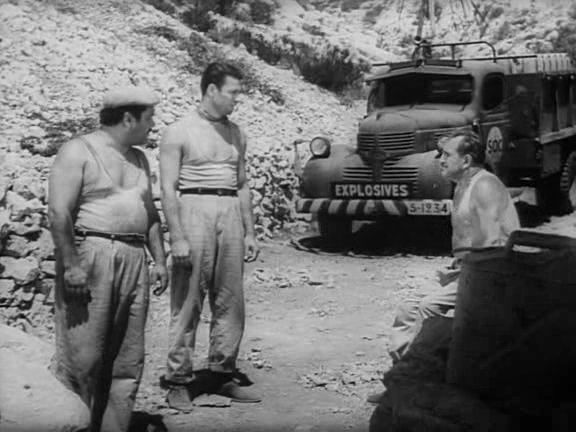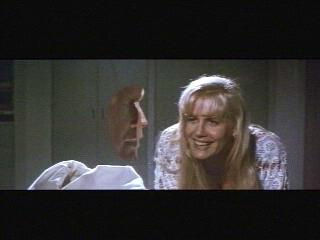VIRIDIANA on DVD
From Cineaste, Vol. XXXI, No. 4, September 2006. — J.R.
Spoilers ahead: The title heroine (Silvia Pinal) of
Luis Buñuel’s masterpiece, a Spanish novice
about to take her final vows, is ordered by her
mother superior to visit her rich uncle (Fernando
Rey), Don Jaime, who’s been supporting her over
the years but whom she barely knows. A
necrophiliac foot fetishist, he’s preoccupied with
how closely his beautiful niece resembles his
late wife, who died tragically on their wedding night,
and somehow manages to persuade Viridiana
to put on her wedding dress, which he’s
faithfully preserved. With the help of his servant
Ramona (Margarita Lozano), he then drugs her with the
intention of raping her, but deeply mortified by
his behavior, ultimately holds back and hangs
himself instead, using the skipping-rope he
previously gave to Ramona’s little girl.
If this opening strongly evokes the horror of a
Gothic novel — a form of literature Luis
Ivan The Terrible, Part Two
From the Chicago Reader (July 1, 1993). — J.R.
The second feature in Sergei Eisenstein’s controversial, unfinished trilogy, also known as The Boyar’s Plot, with a Prokofiev score and a histrionic, campy (albeit compositionally very controlled) performance in the title role by Nikolai Cherkassov (1946). The ceremonial high style of the proceedings has been interpreted by critics as everything from the ultimate denial of a cinema based on montage (under Stalinist pressure) to one of the most courageous acts of defiance in film history (Joan Neuberger and Yuri Tsivian) to the greatest Flash Gordon serial ever made (my own estimation). The second part climaxes in a dazzling, drunken dance sequence that features Eisenstein’s only foray into color. Thematically fascinating both as submerged autobiography and as a daring portrait of Stalin’s paranoia, quite apart from its interest as the historical pageant it professes to be, this is one of the most distinctive great films in the history of cinema — freakishly mannerist, yet so vivid in its obsessions and expressionist angularity that it virtually invents its own genre. (JR)
Pregnant Pas [MARY SHELLEY’S FRANKENSTEIN & JUNIOR]
From the Chicago Reader (November 25, 1994). — J.R.
* MARY SHELLEY’S FRANKENSTEIN
(Has redeeming facet)
Directed by Kenneth Branagh
Written by Steph Lady and Frank Darabont
With Kenneth Branagh, Robert De Niro, Helena Bonham Carter, Tom Hulce, Aidan Quinn, Ian Holm, Richard Briers, and John Cleese.
* JUNIOR
(Has redeeming facet)
Directed by Ivan Reitman
Written by Kevin Wade and Chris Conrad
With Arnold Schwarzenegger, Danny DeVito, Emma Thompson, Frank Langella, Pamela Reed, and Judy Collins.
Through a perverse coincidence, Kenneth Branagh and his wife, Emma Thompson worked simultaneously, on separate continents, on two lousy features about men usurping the reproductive roles of women. In many respects, these movies are radically different: Branagh’s pre-Thanksgiving turkey, misleadingly titled Mary Shelley’s Frankenstein, is the umpteenth screen adaptation of what is arguably one of the greatest feminist novels and perhaps the first serious example of science fiction. Thompson’s movie, a Thanksgiving release, is a Ivan Rietman “family-values” fantasy-comedy about Arnold Schwarzenegger becoming pregnant — a high-concept obscenity that seems inspired by the combined successes of Twins (which also starred Schwarzenegger and Danny DeVito) and Tootsie (which also contrived to show how men make better women than women, a project also taken up by The Crying Game). Read more
In Search of the American Uncle
From the May 1981 American Film. This is the third and last of my Resnais interview pieces from this period to be posted on this site . — J.R.
“You know, for all European kids of my age, America was a kind of fairyland,” recalled fifty-eight-year-old Alain Resnais on a recent trip to the United States. “We were born with the idea that there was another kind of country where everything was easy and perfect, like cartoon films, and there was a lot of money and freedom. I remember that when I was ten and I was looking at the French flag, I didn’t feel a thing. But when I was looking at the American flag, my heart was really beating.”
The French director also remembered that in his youth every French child had a distant relative who had gone off to America and was never heard from again. (In his own case, this was a great-grandfather who had disappeared into the wilds of Virginia.) The typical fantasy would be that the missing relative had made a fortune and would one day return to solve every problem. It’s the concept alluded to by the title of — and briefly mentioned by all three leading characters in — Mon Oncle d’Amérique, Resnais’ eighth and most recent feature, and his first major commercial success. Read more
RED DESERT’s Inconceivable Values
This essay was commissioned in fall 2018 for an exhibition devoted to Michelangelo Antonioni in Tehran curated by Sami Astan. — J.R.

[Antonioni’s] trilogy was concerned with differing aspects of love as the medium of hope in our world. This film [Red Desert] is stripped to naked essence — hope or nonhope unadorned: the prospect of human life in the midst of whirling changes. We live, as we know, in the age of the swiftest transition in history, and all indications are that the speed of change will increase: in everything from household appliances to concepts in philosophy, the whole architecture of thought. Antonioni seems to be saying, without effervescent cheeriness, that what was valuable can be preserved or can be transmuted to a new viability: that the future may contain new, at present inconceivable, values. — Stanley Kauffmann, The New Republic, March 23, 1963
There seems little doubt that Red Desert (1964) represented a major turning point in both the art and the career of Michelangelo Antonioni, and not only because it was his first film in color. Read more
Do Yourself a Favor [HOUSE OF CARDS]
From the Chicago Reader (July 2, 1993). For all my enthusiasm back then, I can’t remember any of this film now. This is one of the unfortunate side-effects of regular reviewing, which nearly always involves a certain amount of hype (in convincing both readers and one’s self that this week’s offerings are important and notable) and a certain amount of forgetting (that you both went through the same song and dance a week ago). — J.R.
HOUSE OF CARDS
*** (A must-see)
Directed and written by Michael Lessac
With Kathleen Turner, Tommy Lee Jones, Asha Menina, Shiloh Strong, Esther Rolle, and Park Overall.
If one of the surest signs of story-telling talent is the capacity to put across an outlandish plot, the first feature of writer-director Michael Lessac is impressive — riveting, exciting, and oddly believable on its own provocative terms throughout. On the page, however, it may sound contrived and pretentious, bordering on some new-age brand of science fiction. So if you want a story that unfolds with all the dramatic force and internal logic needed to compel suspension of disbelief, go see House of Cards before you hear very much more about it, including what I have to say below. Read more
Great Freaks of Nature [GREAT BALLS OF FIRE]
From the Chicago Reader (July 7, 1989). — J.R.
GREAT BALLS OF FIRE
* (Has redeeming facet)
Directed by Jim McBride
Written by Jack Baran and McBride
With Dennis Quaid, Winona Ryder, Alec Baldwin, John Doe, Lisa Blount, Stephen Tobolowsky, and Trey Wilson.
Given that Jim McBride’s film debut was a pseudodocumentary designed to look real (David Holzman’s Diary, 1968), and was followed by an actual diary film that was made to seem fictional (My Girlfriend’s Wedding, 1969), it should be no surprise that Great Balls of Fire, which purports to be a biopic of rock-and-roller Jerry Lee Lewis, is actually a musical-comedy fantasy about virtually imaginary characters.
For those who accept the a priori assumption that most movies are simply dreams and lies, this is only business as usual; in fact, in playing fast and loose with the facts McBride and his longtime collaborator Jack Baran are working in a grand tradition peopled by the makers of most other simpleminded Hollywood biopics. The difference here is that the falsity of their concoction is made nakedly apparent: at least two-thirds of the picture resembles a feature-length music video, patterned in some ways after the rock musicals of 30 years ago. Read more
Bringing Back the Depression Musical
From the Chicago Reader (February 10, 1989). — J.R.
TAP
** (Worth seeing)
Directed and written by Nick Castle Jr.
With Gregory Hines, Suzzanne Douglas, Savion Glover, Joe Morton, Dick Anthony Williams, “Sandman” Sims, Bunny Briggs, and Sammy Davis Jr.
One of the more poignant effects of contemporary Hollywood has been the virtual extinction of at least two of the major genres that served as industry staples during the 30s, 40s, and 50s: the western and the musical. When attempts are made to resurrect these old standbys, a certain self-consciousness often makes itself felt. Such “last westerns” as Once Upon a Time in the West and McCabe and Mrs. Miller, and such “last musicals” as All That Jazz and Pennies From Heaven tend to wear their obsolescence on their sleeves, representing themselves as last-ditch attempts to revivify forms that are no longer part of the present tense, but only nostalgic emblems of an earlier era.
Other recent approaches, however, have avoided such self-consciousness, and behaved as if the genres in question never really left us. Young Guns was a fairly forgettable attempt to bring back the western that populated a conventional example of the genre with several youthful male stars. Read more
DOWN WITH LOVE (2003)
Written for The Unquiet American: Transgressive Comedies from the U.S., a catalogue/ collection put together to accompany a film series at the Austrian Filmmuseum and the Viennale in Autumn 2009. — J.R.
One reason I took so long getting to see this movie (2003) was the number of friends who assured me it was nothing special. Most of them seemed to go along uncritically with the publicists’ claim, echoed by reviewers, that it was a simple point-by-point pastiche of three late-50s and early-60s comedies starring Rock Hudson, Doris Day, and Tony Randall: Pillow Talk (1959), Lover Come Back (1961), and Send Me No Flowers (1964). These films have never appealed to me in the slightest, though Mark Rappaport did an expert job of unpacking them in his 1992 Rock Hudson’s Home Movies. But Down With Love is also an affectionate satire of late-50s and early-60s studio glitz that often contradicts the pastiche. The filmmakers, who were too young to experience this era themselves, make plenty of errors, starting with a Fox CinemaScope logo (wrong studio and too late for that logo) and the snazzy rainbow credits (too hyperactive for the time). Then we get palatial Manhattan apartments (much more identified with How to Marry a Millionaire in 1953 and The Tender Trap in 1955) and bubble-gum-colored media blitzes (as in Funny Face and Will Success Spoil Rock Hunter? Read more
Chinese Displacements in 24 CITY
An essay written for the Cinema Guild’s DVD, released in 2009. — J.R.
24 City is a documentary about the transformation of Factory 420 in
Chengdu from the secret manufacture of military aircraft engines in 1958
to, after the Vietnam War, a downsized and remodeled facility producing
consumer products, and then, more recently, into a privately owned
real-estate development called “24 City”. This sounds pretty
straightforward, but because it’s a Jia Zhangke film, it qualifies as an
adequate description only in the most skeletal fashion. Factory 420
employed almost 30,000 workers, so a lot of life experience and
displacement is involved in this multifaceted story — a good half-
century of Chinese history. And Jia is so desperate to discover the
truth of his subject that he’s willing to employ anything and
everything, including artifice, if this will bring him any closer
to what urban renewal is the process of quickly obliterating.
The theme of his film — of all his features to date, in fact — is
the displacement coming from historical upheavals in China
and the various kinds of havoc they produce: physical, emotional,
intellectual, political, conceptual, cultural, economic, familial,
societal. And sometimes the style involves a certain amount of
displacement as well, such as when he cuts from a speech in late
2007 about recent changes in “24 City” before a full audience in
an auditorium to a shot of an almost empty stairway that plays
over the same speech, with one figure climbing the steps on two
successive floors. Read more
They Drive by Night: The Criticism of Manny Farber
I’m reposting this as a sort of adjunct to David Bordwell’s excellent two-part study of Manny Farber (available here and here). My relatively recent review of Farber on Film can be accessed here.
This very personal essay was written in 1993 for my first collection, Placing Movies: The Practice of Film Criticism. I’ve updated a few facts, all placed in square brackets, and corrected some typos, including one that appeared on the first page of the essay in the book, much to my irritation (as well as Manny’s) ….The photograph at the very end of this piece, before the new Afterword, taken by Andy Rector, shows Manny and Patricia with Gabe Klinger. — J.R.
They Drive by Night: The Criticism of Manny Farber
By Jonathan Rosenbaum
“What is the role of evaluation in your critical work?” Manny Farber was once asked in an interview. “It’s practically worthless for a critic,” Farber replied. “The last thing I want to know is whether you like it or not; the problems of writing are after that. I don’t think it has any importance; it’s one of those derelict appendages of criticism. Criticism has nothing to do with hierarchies.” A few years later, in another interview — published in French, so I can’t quote from it verbatim — he expressed his irritation with Pauline Kael writing about RAGING BULL as if she knew what was good or bad in every shot, in every scene. Read more
Movie Love (on CINÉMA CINÉMAS, 1982-1991)
From Moving Image Source [movingimagesource.us], posted March 5, 2009. The last time I checked, the box set Cinéma Cinémas was still available from French Amazon, for 25.56 Euros. — J.R.
How does one distinguish American cinephilia from the original, hardcore French brand? Based on an exchange I had with French critic Raymond Bellour and several other friends a dozen years ago — a round of letters first published in the French film magazine Trafic that later grew into a collection in English that I co-edited with Adrian Martin, Movie Mutations: The Changing Face of World Cinephilia — there’s some disagreement about how serious a role French cinema actually plays in “classic” (i.e., French) cinephilia. According to Raymond, spurred in part by remarks from the late Serge Daney — a mutual friend and the founder of Trafic — modern French cinephilia was from the outset basically American, as suggested by the archetypal question, “How can one be a Hitchcocko-Hawksian?”:
It’s a question of theory, but even more of territory. This is what necessarily divides me from Jonathan, in whom cinephilia was born, like in everyone else, through the nouvelle vague, but who, as an American, takes the nouvelle vague itself as an object of cinephilia — whereas the cinephile, in the historical and French sense, trains his sights on the American cinema as an enchanted and closed world, a referential system sufficient to interpret the rest. Read more
Some Festivals I’ve Known: A Few Rambling Recollections (Part 2)
Commissioned by Richard Porton and written for (and published by) On Festivals: 03 (Dekalog), edited by Richard Porton, New York: Columbia University Press, 2009. Because of the length of this, I’m running it in two parts, and this is the second part. — J.R.
Apart from New York and Cannes, I can almost count the other film festivals I attended during the 1970s on one hand: San Sebastian in 1972; London in 1974–76 (after moving to London to work for the British Film Institute, as assistant editor of the Monthly Film Bulletin); Edinburgh in 1975 and 1976 (which I covered both years for Sight and Sound); Filmex in Los Angeles in 1977–78 (after I moved from London to San Diego, to teach film at the University of California); the Toronto Festival of Festivals, thanks to David Overbey, in 1978; and Venice, to attend a three-day conference called The Cinema in the 80s, in 1979.
The San Sebastian bash, held back then in July, was by far the glitziest -– an event that incorporated not only a good many midnight banquets at country clubs, but also a trip to Pampelona to attend the bullfight, with Howard Hawks — the festival’s guest of honor, head juror, and the focus of the festival’s retrospective — holding court. Read more
Some Festivals I’ve Known: A Few Rambling Recollections (Part 1)
Commissioned by Richard Porton and written for (and published by) On Festivals: 03 (Dekalog), edited by Richard Porton, New York: Columbia University Press, 2009. Because of the length of this, I’m running it in two parts. — J.R.
I’m pretty sure the first film festival I ever attended was the third New York Film Festival, at age 22 in fall 1965, to see Alphaville. In 1963, I probably would have attended the first New York Film Festival if I hadn’t transferred from Washington Square College to Bard College, two hours up the Hudson, about half a year earlier. Later that same year, I took over the Friday night film series at Bard, but every once in a while I’d forego one of my own selections in order to take a weekend trip to New York and see something new I was especially curious about; my first looks at Muriel and Dr. Strangelove were during two such excursions. And my curiosity about what Jean-Luc Godard would do with science fiction was enough to persuade me to hop on the train or catch a ride with a classmate. As it turned out, I found the film silly, not really understanding most of its allusions to contemporary Paris or German expressionist cinema. Read more
Soft Censorship [THE WAGES OF FEAR and MEMOIRS OF AN INVISIBLE MAN]
One ironic footnote to the following article, which ran in the March 6, 1992 issue of the Chicago Reader, is that it was itself subjected to a kind of “soft censorship”. Specifically, my editors refused to allow me to allude to having known Chevy Chase personally as a classmate at Bard College during the mid-1960s, which I thought gave some additional weight to some of my reflections about the personal nature of Memoirs of an Invisible Man. (Since I no longer have access to my initial draft, I can’t spell this out here in any detail, except to note that Chase’s jazz piano now figures in the final draft only as a parenthetical detail.) Not only did Chevy and I share a course or two, but we also bonded in various ways through our mutual interest in jazz: in a few student jam sessions, I played piano while Chevy played drums (although he also played some piano even then), and we collaborated at one point with Blythe Danner (another Bard classmate, and a jazz vocalist at the time) on a successful project to bring Bill Evans and his trio to campus to give a concert. —J.R.
THE WAGES OF FEAR
*** (A must-see)
Directed by Henri-Georges Clouzot
Written by Clouzot and Jerome Geronimi
With Yves Montand, Charles Vanel, Vera Clouzot, Folco Lulli, Peter Van Eyck, and William Tubbs. Read more


